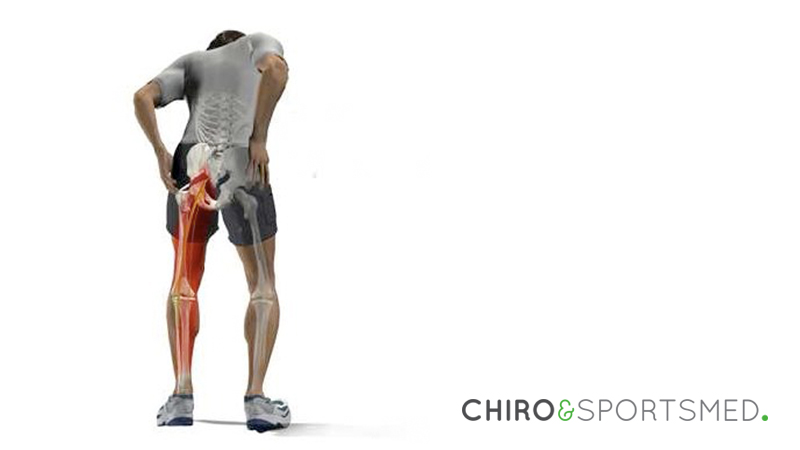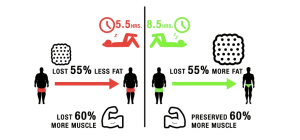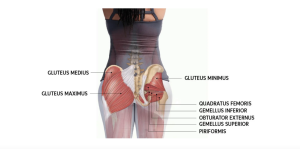Piriformis Syndrome is a condition caused by the compression or irritation of your sciatic nerve by the piriformis muscle. The Piriformis muscle is located in the buttock region, and the sciatic nerve runs below it. As the muscle tightens and spasms it puts pressure on the sciatic nerve. The pressure causes irritation of the sciatic nerve sending tenderness, pain, tingling, or numbness through your butt, and sometimes in the back and down your leg, calf, and into your foot. You’ll feel the sensations whenever the muscle is contracted—in extreme cases, just from standing and walking—or during running or exercises like lunges, stairs, squats, etc..
What is the Piriformis muscle?
Most people think of their butt as just the gluteus maximus, the largest of the three-glute muscles, it’s certainly not the only one. One of them is the piriformis, a small muscle deep in your glute that connects the front of your sacrum (a bone near the bottom of your spine, just above the tailbone) to the outside of the top of your femur (thigh bone). The piriformis muscle is very important in the lower body movement. The muscle is a flat, band-like muscle and helps stabilizes the hip joint and lifts and rotates the thigh away from the body. This enables us to walk, shift our weight from one foot to another, and maintain balance. The muscle is used in almost every motion of the hips and legs especially in sports that involve lifting and rotating the thighs. The muscles in your buttocks help you to get up after bending down. Piriformis syndrome reduces your ability to walk, sit for a long period of time, and to bend forward to pick something up.
What are the Causes
Injuring or irritating the piriformis muscle can cause muscle spasms. When your glutes and piriformis are tight and fatigued they can cause you to have a sore lower back and hamstrings, poor balance, and even shooting nerve pain down your leg due to sciatica. (Your sciatic nerve shoots through your piriformis. When inflamed, the piriformis compresses this nerve causing the pain.) It is usually overuse which causes the piriformis muscle to go into spasm resulting in pressure on the sciatic nerve.
It has been suggested that this condition would be better referred to as piriformis impingement due to the impingement of the sciatic nerve. A common cause of piriformis syndrome is tight abductor muscles on the inside of the thigh. This means the abductors on the outside cannot work properly and so put more strain on the piriformis muscle.
Overuse can irritate or injure the muscle. Muscle spasms may come from:
- Sitting for long periods
- Over-exercising/overtraining
- Running, walking, or doing other repetitive activities
- Playing sports
- Climbing stairs
- Lifting heavy objects
Trauma can also affect muscle irritation and damage. This may be due to:
- Car accidents
- Falls
- Sudden twisting of the hip
- Penetrating wounds
What are the Symptoms
Sciatica is the main symptom of piriformis syndrome. Other symptoms include:
- Tenderness or a dull ache in the buttock
- Tingling or numbness in the buttock and along the back of the thigh, calf, and foot (sciatica)
- Difficulty sitting
- Increased pain after prolonged sitting
- Pain that gets worse with activity
- Lower body pain that is so severe it becomes disabling
- Reduced range of motion of the hip joint
Symptoms of piriformis syndrome often become worse after prolonged sitting, walking or running, and may feel better after lying down on the back. The pain usually affects just one side of the lower body. But it can also occur on both sides at the same time.
Treatment for Piriformis Syndrome
In some cases, you may not need medical treatment. The following self-care tips can help relieve pain.
- Avoid activities that cause pain, such as biking or running. You can resume these activities once the pain is gone.
- Be sure to use proper form and equipment when doing sports or other physical activities.
- Try ice or heat.
- Use an ice pack for 15 to 20 minutes every few hours. Wrap the ice pack in a towel to protect your skin. It may be more helpful to combine a gentle massage with the ice. Lie on the stomach and have someone gently massage the painful area with a large ice cube. If ice is applied directly to the skin (instead of a cold pack), limit it to 8 to 10 minutes to avoid an ice burn.
- If using a heat pack, lie on the stomach and place the heat pack on the painful area for up to 20 minutes. Be sure to avoid falling asleep on a heat pack, as this may lead to skin burns.
- Some people find it helpful to alternate cold with heat. Alternate the cold pack with a heat pack. Don’t use a heat pack for longer than 20 minutes at a time.
- Follow your provider’s instructions for doing special stretches. Stretches and exercises can relax and strengthen the piriformis muscle.
- Use proper posture when sitting, standing, or driving. Sit up straight and don’t slump.
Your provider may prescribe muscle relaxants. This will help the muscle to relax so you can exercise and stretch it. For severe sciatica pain from piriformis syndrome, an injection may be part of the treatment.
For more severe pain, your provider may recommend electrotherapy such as TENS. This treatment uses electrical stimulation to reduce pain and stop muscle spasm.
Chiro & Sport Med
Our chiropractors at Chiro & Sports Med are committed to providing chiropractic solutions to address your unique needs, whether you are experiencing an irritated nerve, bulging disc, back pain, neck pain, knee pain, headaches, or even muscular tightness and tension. You may be searching for pain relief after an accident or experiencing an injury. Our mission is to help reduce or eliminate pain and to prevent future problems and injury. Above all, we are here to improve your quality of life, well-being, and your ability to live an active healthy lifestyle.
If you would like to make an appointment with one of the chiropractors at Chiro & Sports Med simply call our office on 9817 2005 and one of our friendly staff will organise an appointment for you.





